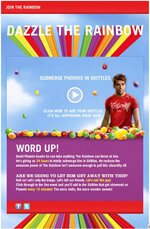By Iain MacMillan, RMM
Speaking at the IAB’s ‘Digital marketing for small businesses’ event last week, we provided a few hints and tips on using social media to help develop relationships with customers, prospects, media and employees.
We focused on six areas of activity as a quick guide to small businesses getting started in social media – and we’d welcome any further suggestions.
Whatever the size of your business, it is vital to listen to online conversations to determine what customers and prospects are saying about your products and services. This will help inform your future social media activity, and will flag any customer service issues. Where customers are discussing your products and services, you should respond quickly and ideally as authentically as possible.
Once you have established a place in your customers’ conversations, you can begin engaging more proactively and building communities in your own social media spaces. You can also establish your position as an authority in relevant conversations by running your own business network to facilitate introductions between key people. Customers and other stakeholders will regard your community as a valuable resource, and you will widen your own network.
Once you have created a community, you can use it to enlist your most loyal customers and encourage them to advocate your organisation, through giving feedback publicly and acting as ambassadors. Enabling feedback and collaboration with customers and employees can also help improve your products and services, with the potential to transform how you do business altogether.
We’d love to hear some more thoughts and opinions on how small businesses can generate value from using social media.
By Simon Preece, Senior Consultant, RMM
If 2010 saw organisations really getting to grips with social media for marketing, 2011 might be the year we see them using social media for internal collaboration as the norm.
Successes and failures – but most importantly, experimentation – saw our awareness of what social media can do for organisations become increasingly sophisticated. Smart organisations are beginning to realise that social media can and should be a benefit for employees as well as customers.
But getting employees to be ‘more social’ isn’t just about how comfortable they are with using @ replies on Twitter – it requires a fundamental shift in how they perceive sharing knowledge in the workplace.
An oft-cited US example is IBM, which has taken the conscious decision not to have a corporate blog – instead empowering employees to drive interactions with customers and help shape the brand online. A decentralised approach has also boosted internal collaboration and knowledge sharing, with 100,000 employees making use of internal blogs to share internal expertise.
Nationwide deployed social media technologies across a number of departments, using Yammer to help redefine the way it interacts with employees. Specifically, the organisation uses Yammer to allow employees to send messages to colleagues or teams either online or via mobile. Within ten months, Nationwide had more than 8,500 employees using Yammer, ensuring knowledge and ideas are shared rather than siloed.
While not all organisations will be so technology-focused, these are good examples of getting the workforce to ‘buy into’ social media. Involving employees right at the start is key, rather than imposing rules of engagement pre-defined by those at the top of the organisation.
That isn’t to say there shouldn’t be some pre-determined guidance – rather, organisations should enable employees to feed in their own knowledge about social media best practice. Providing clear starter guidelines and specific, practical examples of how social media can help in employees’ day-to-day jobs will be helpful, but organisations should also assume these will change. Kodak prefaces its online tips for employees in social media simply with: ‘Feel free to edit to suit your needs’.
For businesses exploring this area, getting employees who are already keen to champion social media on board and enthusiastic will help reassure anyone who is feeling uncertain. This kind of grass-roots persuasion will help give employees the guidance and confidence they need to get fully involved with social media.
By Shona Ghosh, RMM
2010 has seen brands becoming more adventurous with social media – partly out of a sense that it’s really exciting and partly as those up at the top realise that good social media can really turn a brand around.
What has been particularly exciting to see is how some brands are really beginning to understand the meaning of ‘social’ – true user interaction versus shiny digital ideas for consumption.
Some, but not all. Angrily, brilliantly satirising BP’s response to the Deepwater Horizon oil spill was ‘Leroy Stick’, the man who set up @BPGlobalPR. In response to the oil company’s sustained social media campaign, Leroy wrote for the Huffington Post advising BP to fire everyone in its PR department. He writes:
“You know the best way to get the public to respect your brand? Have a respectable brand.”
Read more…
By Shona Ghosh, RMM
What’s the best way to supercharge a brand online?
Social media, naturally. At least, that’s what RMM and Skive had to convince a panel of digital ‘dragons’ to think at IAB’s Engage 2010 – against pitchers for in-game advertising, target marketing and performance marketing. You can see the presentation from Tom Ollerton and Iain MacMillan in full below.
They argued word-of-mouth is key when it comes to consumers making decisions about what to buy. I bought my Canon Ixus entirely on the basis of six recommendations from friends on Facebook and it seems I’m not alone – Nielson stats show that 90% of consumers trust recommendations from people they know. Advocacy from friends is evidently a persuasive message.
But unlike clickthroughs, advocacy can be difficult for a brand to manufacture or monitor directly – or is it? Social media, at its heart, is public breeding ground for opinion. These are the platforms which encourage sharing, recommending, the exchange of information, and chatting – and that will revolve around brands and products as much as anything else.
Social media lets brands find, enter and facilitate these conversations to fuel advocacy and answer complaints. A prime example is Dell creating a community for its users, encouraging customers to turn potential complaints into ideas for improvement. Having implemented 425 of their users’ ideas, the company claims to have seen a 30% decrease in negative commentary online.
Our message was simple, but won over the dragons and IAB voters -social media supercharges your brand because, for marketers, it is the best way to drive advocacy.
By Shona Gosh, Social Media Analyst RMM
 Many established companies learn the hard way that venturing into social media means relinquishing the concept of carefully controlled branding. Once you’re in the social space, your branding and products become fair game to public perception (and evisceration, on occasion).
Many established companies learn the hard way that venturing into social media means relinquishing the concept of carefully controlled branding. Once you’re in the social space, your branding and products become fair game to public perception (and evisceration, on occasion).
You have to hand it to Skittles UK. They’re obviously happy to market Skittles in a way which plays to alternative Skittle uses (projectile ammo) rather than a carefully controlled message (these sweets are yum). Few large-scale companies would be willing to embrace alternative product perceptions – let alone take it to the next level.
The campaign saw Skittles UK take on ‘Dave Phoenix’, who challenged them to completely submerge him in Skittles in 24 hours. The playful campaign was well-pitched, shamelessly stealing the ‘macho guy’ theme from Old Spice, livestreaming the carnage and providing excellent build-up and post-event content.
As PR stunts go, it was perfectly executed – and Skittles should be applauded for some creative brilliance.
Perhaps a more interesting question is whether Dazzle the Rainbow was genuinely social. Metrics such as live stream viewing figures and shares are not yet available. But YouTube viewing figures, comment numbers and ‘like’ numbers suggest that Skittles did not leverage a large proportion of their 1.3 million existing fans. We can all agree that it was a great PR stunt. But while shiny PR-able ideas are fun, true social media savvy comes from genuine community initiatives.
How could this have been more community-focused? While Skittles-throwers were encouraged to click a Facebook ‘Share’ button, there was little social impetus to do so. Once you had thrown your Skittles there was, for example, no social scoreboard mechanic comparing your Skittles score against friends. For all you knew, you were a lone Skittles consumer throwing sweets at another Skittles consumer. Rather than encouraging group activity, Dazzle the Rainbow encouraged the activity of many individuals. It may seem like a fine line, but it’s the difference between an online PR campaign and a truly social one.
At our first session for our Rising Voice in social media programme from RMM took the delegates through the 6 types of social media. Matt used a colourful party planner analogy with case studies and tips to do this.
Watch the below to see the full presentation…
Our first session of the Rising Voice in Social Media kicked off yesterday. , Associate Director – Social Media at Tamar (and hardcore Eva Longoria Parker fan) talked our delegates through how to get the most out of blogging and Twitter, with some case studies and best practice examples.
By Iain MacMillan, RMM and the IAB Social Media Council education sub-group
When considering how to make best use of social technologies and media, it can be hard to know where to start. Making an organisation’s interactions amongst its employees, customers, enthusiasts or prospects more social can have numerous benefits -and can be achieved in many and various ways.
With this in mind, we believe a broad framework of social media activity types would be most beneficial – not only for those who lack experience in this area, but also for people for whom a simple check-list might be a useful aide memoire.
We’ve devised a list of six ways in which brands can use social technologies to impact upon a business’ marketing function.
Read more…



